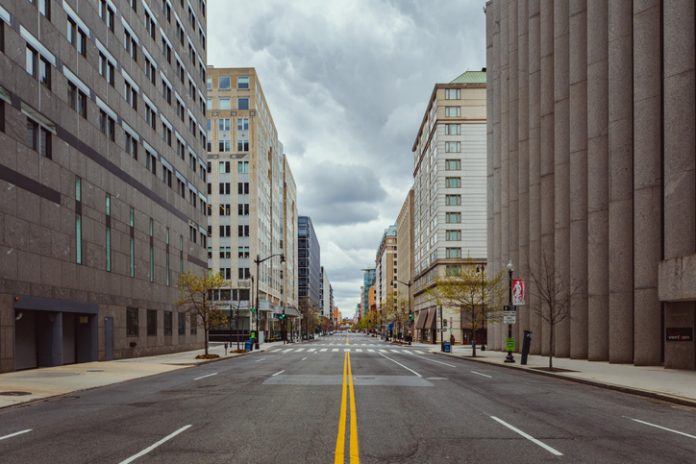LONDON — In April 2020, U.S. hotel occupancy rates declined 73 percentage points from a year prior, average room rate dropped, and RevPAR fell 95.2 percent year-over-year (YOY) to a single-digit number, on a per-available-room basis, according to HotStats data.
With virtually no ancillary revenue generated, including F&B revenue of below $1 per-available-room, TRevPAR decreased 95 percent YOY. While closed hotels or those running bare-bones operations saved on the expense side, including total labor costs down 73.5 percent YOY, gross operating profit per available room still suffered tremendously, down 122.8 percent YOY to -$26.34—the second consecutive month of GOPPAR as a negative value.
While YOY comparisons have historically been the norm of performance measurement to capture seasonal fluctuation, COVID-19 has made month-to-month comparison a worthwhile tool to measure real improvement or deterioration. Hoteliers are hoping that April is the bottom: Between March and April, TRevPAR declined 87 percent; GOPPAR worsened 106 percent.
Profit & Loss Performance Indicators – Total U.S.
|
KPI |
April 2020 vs. April 2019 |
YTD 2020 vs. YTD 2019 |
|
RevPAR |
-95.2% to $8.81 |
-42.8% to $97.43 |
|
TRevPAR |
-95.0% to $14.40 |
-41.3% to $159.32 |
|
Payroll PAR |
-73.5% to $25.54 |
-22.7% to $74.28 |
|
GOPPAR |
-122.8% to -$26.34 |
-67.7% to $32.62 |
Washington, D.C.
For the nation’s capital, where a stay-at-home order isn’t set to expire until June 8, April was a consecutive month of hotel hardship, with many big-box hotels idle and other hotels operating amid a ghost town of vacant offices and a paucity of tourists normally in town to view the cherry blossoms in full bloom.
Occupancy rate for April in Washington, D.C., was at an infinitesimal level and even with rate holding fairly strong (22.7 percent down from the same time a year ago), RevPAR cratered 98.3 percent YOY. TRevPAR suffered a similar fate, falling 98.5 percent YOY.
With revenue at nearly zero, combined with some lingering expenses that persevere despite property closures and scaled-back operations, GOPPAR declined 119.5 percent YOY—down to -$33.34. From March to April, GOPPAR was down 18 percent.
Profit & Loss Performance Indicators – Washington, D.C.
|
KPI |
April 2020 v. April 2019 |
YTD 2020 v. YTD 2019 |
|
RevPAR |
-98.3% to $4.32 |
-52.1% to $92.91 |
|
TRevPAR |
-98.5% to $6.00 |
-50.0% to $151.73 |
|
Payroll PAR |
-82.5% to $22.55 |
-21.6% to $97.12 |
|
GOPPAR |
-119.5% to -$33.34 |
-98.1% to $1.87 |
New Orleans
New Orleans, a city hit initially hard by the coronavirus, has seen progress flattening the curve, and with just over 7,000 confirmed cases, is now in the first phase of reopening. The city’s economy relies heavily on tourism, especially in the French Quarter, where famed Café du Monde reopened in May. Meanwhile, French Quarter Fest, slated for October, was officially scrapped.
April data was naturally and drastically down. The city’s occupancy was down 78 percentage points over the same time a year ago and 26 percentage points from March. That, combined with a sharp decline in average rate, led to a 95.8 percent decline in YOY RevPAR. The drop in RevPAR from March to April was especially pronounced, declining 88 percent.
The dearth of revenue, both rooms and ancillary, led to a sharp decline in TRevPAR, which was down 94.9 percent YOY and 87 percent from March.
GOPPAR for New Orleans hotels fell 110 percent YOY and reached a negative value for the first time, at -$12.39.
Profit & Loss Performance Indicators — New Orleans
|
KPI |
April 2020 vs. April 2019 |
YTD 2020 vs. YTD 2019 |
|
RevPAR |
-95.8% to $7.32 |
-42.9% to $97.28 |
|
TRevPAR |
-94.9% to $13.00 |
-40.8% to $151.11 |
|
Payroll PAR |
-80.1% to $12.63 |
-25.5% to $48.45 |
|
GOPPAR |
-110.1% to $-12.39 |
-54.9% to $55.06 |
While it’s still too early to tell, May could see the first buds of a travel rebound in the United States, if the more sanguine trends in China follow suit. The numbers will still pale in comparison year-over-year, but month-to-month, things potentially could be getting better.











